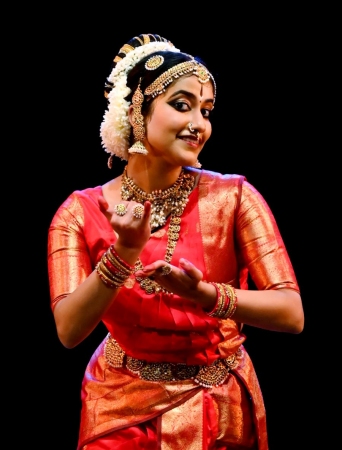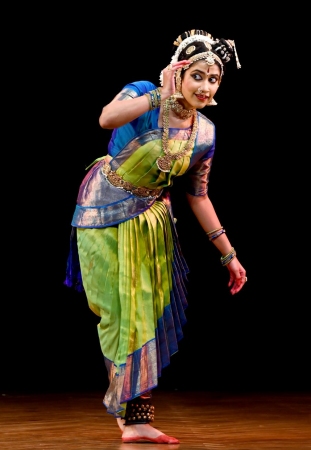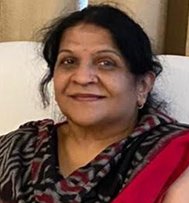
|   |

|   |
Fluidity in form - Ranee Kumar e-mail: ranee@journalist.com January 2, 2024 Kuchipudi dancer-guru Deepika Reddy's daughter and disciple Shloka Reddy's Natyaradhana, a full-fledged solo repertoire, was a mature presentation with complete control over the medium. Hence it calls for a critical appreciation in right earnest.  Though set to the traditional format, each piece was unique and diverse. From the customary invocation (Amba paraku) to lord Ganesha in the mandatory Gambheera Nata raga to wrapping up with the Tillana, it had all the trappings of a 'complete' repertory. Elements like sloka of Adi Shankara interspersing the Oothukadu kriti Sri Vignarajam bhaje... at the very outset and Kalika Ashtakam verses in the Rudrama, the essential dramatic component of Kuchipudi in the latter - both in attire, props and action - more than compensated the divergence from absolute traditional repertoire. There was lot of care and creativity in crafting the series of dance pieces - the changing backdrop, costume change and most of all, the inclusion of suitable rasa highlighting the theme of each dance piece: Rudrama, true to the name had roudra as its dominating artistic emotion; Godha was suffused with shringara bhakti being its essential component. The invocatory Sri Vignarajam itself was inlaid with adbhuta lauding the qualities of the lord. The best - in which many rasas flow seamlessly - was the Madhuram-madhuram (excerpt from dance drama Krsna Leelalu) going by the fact that lord Krsna is a poorna (complete) avatar and hence his exploits/miracles range across all the nine rasas. Shloka proved that she is a chip off the old block with her very first opening statement. She fanned her body and hasta in curvaceous stances in keeping with the deity she was depicting, viz Vigneshwara, with an elephant head and gait. The closure of this piece was a thing of beauty with the artiste mimicking the mooshika (mouse), the vahana (carrier) of the lord. The interlacing of mnemonics to the Adi Shankara sloka enhanced the verse. Krsna's life incidents are timeless marvels and all-time favourite with any dancer and the audiences too. Madhuram-madhuram in chaste Telugu replaced the traditional Krsna Shabdam with aplomb. The entire tapestry was rich - lilting music, the flow of lyric and the fluidity with which the episodes of Krsna's life were executed both in footwork delineations and expressions. Two aspects are worth a mention: Shloka with a natural exuberance was able to get under the skin of the multi-dimensional character of Krsna. Her vivacity and vivid abhinaya mirrored Krsna to the core. The expressive depiction of sudigaali ai... was very impressive. By the same token, the Venna donga part fell a wee bit short of perfection, in the sense this talented dancer should have moulded her vision into that of a child Krsna stamping his feet petulantly as the hung butter pot is not reachable despite his childish effort! The quintessential Kuchipudi plate dance was a fitting finale. Rudrama, pravesha daruvu / eka patrabhinayam, was lengthy enough to cover the gamut of the short but potent annals of Kakatiya history. Set to Samudrapriya-Dhenuka raga, this unique piece had excellent lyrics and dance but a lot more inputs could have enriched it and placed it on a pedestal as it deserves. For instance, the raga could have been soft flowing Madhyama interspersed with more fast-tracked and rhythmic raga like Revati to alternately depict sword wielding scenes where rigour is required to enhance the rasa within. So too, strong, vigorous jatis with fleeting, spring and leap footwork to show a warrior queen would be both artistic and realistic. Shloka has to work on her facial abhinaya when playing Rudrama, the ruthless warrior of the middle ages - the merciless expression in eyes and facial muscles will lend an air of authenticity to the traits of this historical personality. A mridangam beat prior to the pravesha daruvu would have suited the theme than a string instrument. Rudrama can go places if reworked and presented as a solo. And, going by her virtuosity, Shloka can get into the skin of the character like she has done for Goda, with effortless ease.  Goda (Andal) again excerpted from Goda Kalyanam was a piece of artistry and beauty. The devotion and innocence of the maiden who loved and wished to wed none other than the lord himself was brought out with artistic sensibility and sensitivity like the scene where she rings the temple bells, a daily ritual as one enters the premises of the sanctum. Lucid nritya lent a vivid portrayal. Kudos to Shloka for handling the madhura bhakti emotion with her soulful expressions. The Balamuralikrishna Tillana in Kadanakuthuhalam, a toe-tapping raga, suits Kuchipudi to a T. And in Shloka's feet, it achieved its glory. Deepika Reddy's nattuvangam was excellent and so was the orchestra. DSV Sastry as usual was compelling with his melodic tones; Sai Kumar on the violin and Rajagopalacharya on the percussion are stalwarts who were stupendous. VBS Murali on the flute and B. Sai Prasad Raju on the veena were distinct and mellifluous. Jayakumar Acharya's special effects were visible all along. The prototypical salam daruvu greeted us towards the end with the Mangalam. Alarmel Valli's assessment of the dance and dancer was very forthcoming; a short video film on Shloka (third generation dancer in the family) by her brother was tinged with love and affection. The event held under the aegis of 'Deepanjali'- school for excellence in Kuchipudi, at Hyderabad was one of its kind in its subtlety and aesthetics.  Ranee Kumar is a journalist who brings in three decades of hard core journalistic experience with.mainstream papers like the Indian Express and The Hindu to arts reporting. Her novel 'Song of Silence' and guest editing of attenDance widen her horizon. |